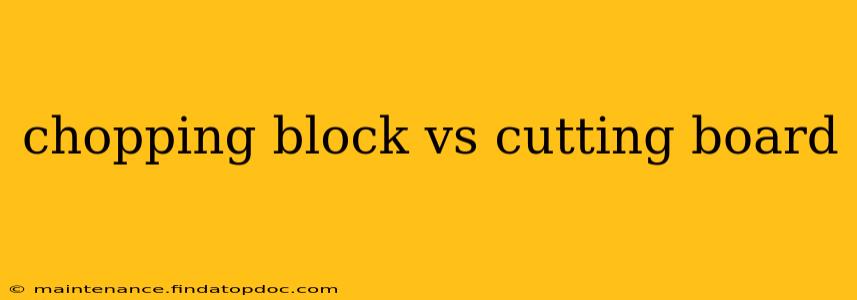Choosing between a chopping block and a cutting board can feel overwhelming. Both are essential kitchen tools for prepping ingredients, but they differ significantly in material, size, weight, and overall purpose. This guide will delve into the key distinctions to help you make the right choice for your culinary needs and kitchen style.
What is a Chopping Block?
A chopping block is typically a large, heavy, and sturdy cutting surface, often made from wood (like butcher block) or other durable materials like granite or concrete. Its substantial size and weight provide exceptional stability, making it ideal for tackling large, tough ingredients and vigorous chopping tasks. Many chopping blocks are designed to be end-grain, meaning the wood grain runs vertically, creating a self-healing surface that’s less prone to damage from repeated chopping.
What is a Cutting Board?
A cutting board, on the other hand, is usually smaller and lighter than a chopping block. They come in a wide array of materials, including wood, plastic, bamboo, and even glass. Cutting boards are versatile and generally more portable, making them suitable for various tasks, from delicate herb mincing to slicing vegetables for a salad.
Chopping Block vs. Cutting Board: Key Differences
Here's a comparison table highlighting the key differences:
| Feature | Chopping Block | Cutting Board |
|---|---|---|
| Size | Large | Small to medium |
| Weight | Heavy | Light to medium |
| Material | Wood (end-grain butcher block), granite, concrete | Wood, plastic, bamboo, glass, etc. |
| Stability | Excellent | Good to fair (depends on material and size) |
| Portability | Low | High |
| Maintenance | Requires regular oiling (wood) | Easier to clean |
| Cost | Generally more expensive | Generally less expensive |
| Durability | Very durable | Varies depending on material and use |
What are the pros and cons of each?
Chopping Blocks:
Pros:
- Superior stability: Ideal for powerful chopping and heavy-duty tasks.
- Self-healing surface (wood): End-grain wood blocks are more resistant to knife damage.
- Aesthetically pleasing: Can add a rustic charm to your kitchen.
- Durable: With proper care, a good chopping block can last for decades.
Cons:
- Heavy and bulky: Not easily portable.
- Requires maintenance: Wooden blocks need regular oiling to prevent cracking and warping.
- Expensive: High-quality chopping blocks can be a significant investment.
Cutting Boards:
Pros:
- Lightweight and portable: Easy to move around the kitchen.
- Variety of materials and sizes: Allows for specialized boards for different tasks (e.g., separate boards for meat and vegetables).
- Easy to clean: Most materials are dishwasher safe (check manufacturer's instructions).
- Affordable: Many options available at various price points.
Cons:
- Less stable: Can wobble or slide during vigorous chopping.
- Prone to damage (some materials): Plastic and bamboo boards can get scratched or dull knives faster than wood.
- May harbor bacteria (some materials): Proper cleaning and sanitization are crucial.
What material should I choose for my cutting board?
The best material depends on your priorities:
- Wood: Durable, self-healing (end-grain), aesthetically pleasing, but requires regular oiling.
- Plastic: Affordable, easy to clean, dishwasher safe, but can scratch easily and dull knives.
- Bamboo: Sustainable, relatively durable, and aesthetically pleasing, but can be less water-resistant than plastic.
- Glass: Easy to clean, sanitary, but very hard on knives.
How do I care for my chopping block or cutting board?
Proper care is essential to extend the lifespan of your chopping block or cutting board. Wooden boards should be oiled regularly to prevent cracking and warping. All boards should be cleaned thoroughly after each use with hot, soapy water. Avoid putting them in the dishwasher unless specified by the manufacturer. Regular sanitization is also recommended.
Which is better for me?
The best choice depends on your individual needs and preferences. If you prioritize stability and durability for heavy-duty chopping, a chopping block is the way to go. If you need something lightweight, portable, and affordable, a cutting board will likely be a better option. Consider having both for different tasks in your kitchen.
